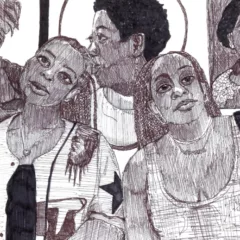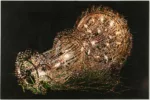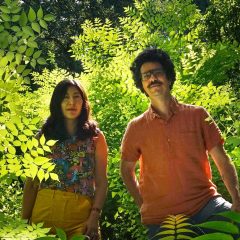—Andrea’s trip to Ireland earlier this year unearthed an exhibit on the idea of touch and some 4-minute (yes, 4-minute!) theater pieces. Her review explains it all.–the Artblog editors———————
Detouched, a group show curated by Anthony Huberman, was on view at Project Arts Centre from Jan. 25 to March 30, 2013. Huberman’s thesis in inventing the neologism, detouched, was that by merging the hand with the machine, contemporary technology generates a detached sense of proximity, or a sense of detouch.
The internet may bring us information at one remove. Art almost always does. But successful art conveys the sensation of touch, as real as reality, but framed by the artist’s vision.
I was certainly carried along with A. K. Burns, mucking about in Wellington boots in a muddy puddle, and Sunah Choi, caressing the streets and sidewalks of Dublin via the technique of rubbing. The images effectively touched my imagination, and the repeated focus on touch made me acutely aware of my body as I walked around the gallery, much as one feels itchy on seeing certain irritants.

The five video monitors of A.K. Burns’ touch parade were sited at the height of the body on which each focused: the video detail of a figure in sneakers, playing with then crushing an egg and a cucumber, sat on the ground; legs moving about in the mud puddle were at hip height; bare feet working the pedals of a car were sited about a foot off the ground; the hands of a seated figure who repeatedly puts on then takes off rubber gloves were shown at lap height, as were those of another seated figure who manipulates, then pops a huge, spherical balloon.
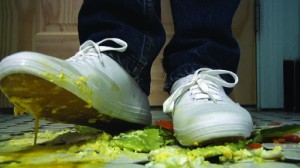
The visceral sensuality of Burn’ subjects was clearly conveyed in the videos, but they have a truly peculiar back story. Burns reproduced scenes she found on the web, taken by people with obsessive-compulsive disorder. Why they would want to share their compulsions with the world, obsession as exhibitionism, is indeed the unanswered question. The distanced touch here is between us and those original, compulsive acts, mediated by the artist’s reenactments.

Seth Price’s wooden silhouettes of one figure eating, another drinking, functioned like an optical puzzle of the Is it a candlestick or two profiles? variety.
I’m not certain whether the curator was interested in our remove from the ingestion or from the equally-physical act of tracing the silhouettes and using a jigsaw. Price’s second piece was a group of vacuum-formed, clear plastic masks, hanging nestled together. Lacking eye holes, they suggested contemporary death masks – made from molds formed directly from the body. They also made reference to the plastic clamshells that are a ubiquitous feature of commodity display, turning the face – the most individualized part of the body – into yet another mass-produced item for sale.
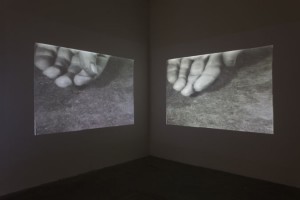
One wall of the gallery was covered with five huge sheets of paper filled with abstract forms.
They were rubbings that Sunah Choi made of various outdoor surfaces she found in Dublin, largely on the ground. Few of us will know the irregularities of the streets and sidewalks as intimately as Choi, even with the thin paper occluding her direct touch. Dennis Oppenheim’s Air Pressure (Hand) was installed on two screens in a corner, allowing the viewer to stand almost within the artist’s hands as the skin rippled in reaction to pressure from a strong blast of air. Without the title it’s not at all clear what we are seeing. The wavey skin looks a bit like reflections in a fun house mirror. But it is clear that these hands are reacting to external forces, if not to direct touch.
Tiny Plays for Ireland
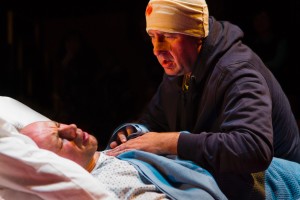
I was also lucky enough to catch an astonishing bit of theater at Project: Tiny Plays for Ireland 2, produced by Fishamble, an organization that supports 60% of the writers of new plays in Ireland. They put out a call for very short (up to four minute) plays, and received 1,700 responses. Last year they produced a program of twenty-five plays, to deservedly sold-out audiences, and a second program this year.
A handful of the works were commissioned from established writers (Maeve Binchey, Colum McCann, et al) but most of the work was by new playwrites.
Whoever arranged the program deserves as much credit as any of the writers. In 100 minutes five actors played more than fifty parts, in a production that flowed seamlessly from quiet contemplation to biting satire, from pathos to situation comedy.
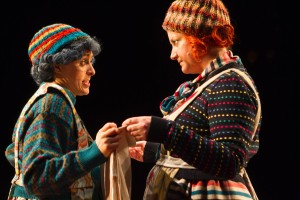
The dramatic range, within such tight constraints, was extremely broad, and the production had superb acting and technical support. The opener was Mark Cantan’s Somewhere, which approached poetry as it described ordinary men and women, doing everyday things, some with self-awareness, others wondering about the lives of the people around them. The play itself worked as a round, ending with the character who opened it.
Some were solo pieces, although most featured two actors and the performance was staged in the round, with actors entering and leaving from four directions.
Two plays had no text at all, including Richie O’Sullivan’s magical Ode to Life, in which a man is dreamily playing a song on an imaginary piano. Most of the plays required no more than simple clothing, suggesting the situation, a few props, and occasionally some very effective, ambient sound.
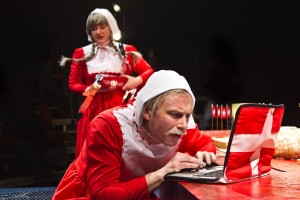
The most elaborate costumes, as well as a bit of a set, were brought out for Federico Storni’s Weekend Abroad (above), a madcap parody of a Swiss couple, contemplating a holiday in Ireland, who run through a litany of wildly-inaccurate stereotypes of the country. They are interrupted by a Leprechaun –six feet tall, but otherwise straight from Central Casting – who plays an actor offended by their slurs against the Irish.
It was played in perfect pitch, and the piece was not only sophisticated in breaking the theatrical frame, but also raised the serious question that recurs with art, about the ethics of presenting deeply offensive ideas, even in the name of debunking them.
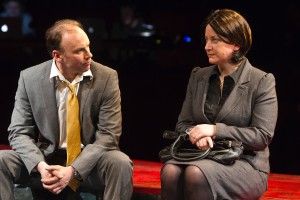
Tiny Plays was a virtuosic display of acting and directing – I can’t imagine anything more demanding than that many changes of character, setting and mood. The performance was a truly memorable experience. I do hope I’ll be in Dublin whenever Fishamble attempts another such display of Ireland’s enormous, theatrical talents.


